Financial review of early learning and childcare in Scotland: the current landscape
Information on the early learning and childcare system in Scotland, with a focus on provision of the funded entitlement.
ELC Providers
This chapter brings together the evidence on providers currently offering funded ( i.e. the free entitlement to 600 hours) and unfunded ELC services. The key sources drawn upon include the latest published data from Care Inspectorate (2014) and the Scottish Government Early Years and Social Work statistics (2015).
Some of the key findings are:
- There are around 3,700 childcare providers (for children of all ages), of whom 2,500 are offering the funded entitlement. In addition, there are 5,600 childminders.
- Excluding childminders, who are 100 per cent private, 46 per cent of all funded and non-funded services are run by local authorities, 29 per cent are run by the private sector and 25 per cent are run by the third sector.
- 1,500 of the settings that offer the funded provision are run by local authorities and the remaining 1,000 by private and third sector partner providers.
- The number of daycare services in a particular area does not notably vary by the local area level of deprivation. However, in poor areas childcare is provided mainly by local authority providers, whereas private providers tend to operate in relatively more affluent areas.
Number and types of providers
Funded and unfunded ELC is offered by childminders, children/family centres, crèches, holiday play schemes, nurseries, playgroups, out-of-school care providers and occasionally other services, such as women's aid centres.
Table 8: Number of services offering services by age of children
| age groups provided for | ||||||
|---|---|---|---|---|---|---|
| Services by service type: | under 1 | 1 | 2 | 3 | 4 | 5 |
| Childminding | 4,882 | 5,172 | 5,233 | 5,257 | 5,268 | 5,261 |
| Children / family centre | 114 | 118 | 130 | 127 | 109 | 96 |
| Crèche | 69 | 71 | 77 | 78 | 76 | 65 |
| Holiday play scheme | 2 | 2 | 2 | 7 | 13 | 44 |
| Nursery | 762 | 777 | 1,057 | 2,378 | 2,368 | 1,708 |
| Out of school care | 4 | 5 | 6 | 37 | 427 | 684 |
| Playgroup | 6 | 10 | 239 | 283 | 252 | 132 |
| Other services | 21 | 25 | 34 | 33 | 38 | 42 |
| Total (excl. Childminding) | 979 | 1,007 | 1,545 | 2,942 | 3,283 | 2,770 |
Source: Care Inspectorate Early learning and childcare statistics 2014
As at December 2014, around 3,733 active daycare services for children [20] are registered to offer services to children up to the age of fifteen. Of those, 2,400 are nurseries. Additionally, there are 5,600 registered childminding services. [21] Not all of these services are delivering childcare to two to four year olds. This is particularly the case for holiday play schemes and out of school care, although some of these services also offer ELC to children who are not yet of school age (see table 8).
Figure 3: Share of settings by type
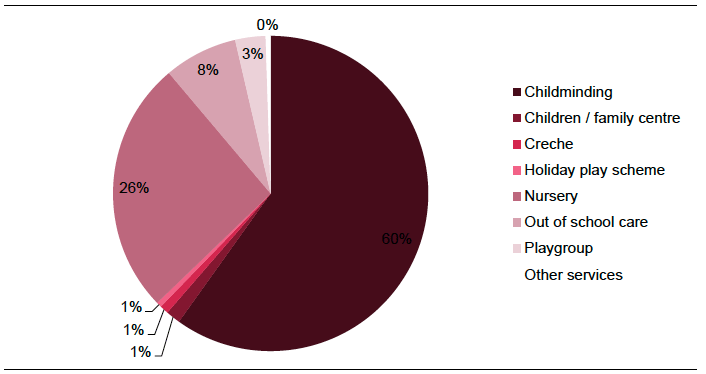
Source: Care Inspectorate Early learning and childcare statistics 2014
There has been a reduction of the number of services between 2012 and 2014, with the number of active services decreasing from 3,800 in 2012 and 3,764 in 2013. On the other hand, workforce numbers and the number of capacity places (maximum attendance at any one time, measured by number of registered places) have increased slightly, indicating a consolidation of the market. [22] , [23]
Figure 4: Childcare providers by sector
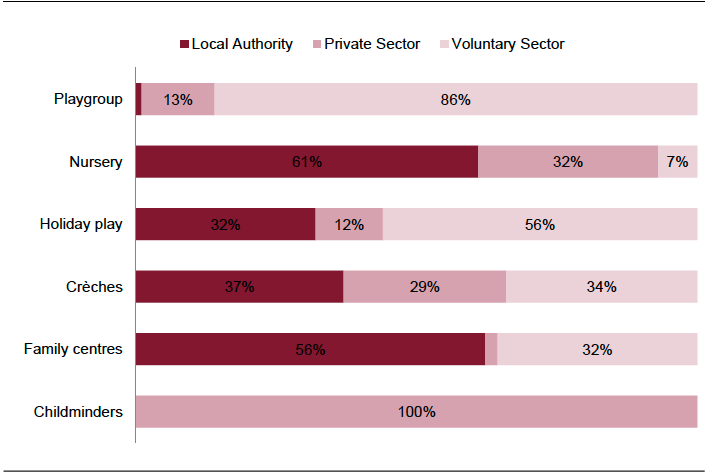
Source: Care Inspectorate Early learning and childcare statistics 2014
Excluding childminders, who are 100 per cent private, 46 per cent of all services (funded and unfunded) are run by local authorities, 29 per cent are run by the private sector and 25 per cent are run by the voluntary sector.
Table 9: Number of registered childcare services
| Number of services | Percentages of services | Total | ||||||
|---|---|---|---|---|---|---|---|---|
| Services by main type: | LA | Private | Non-profit | LA | Private | Non-profit | ||
| Childminding | 0 | 5,572 | 0 | 0.0% | 100.0% | 0.0% | 5,572 | |
| Children / family centre | 90 | 3 | 46 | 64.7% | 2.2% | 33.1% | 139 | |
| Crèche | 31 | 24 | 28 | 37.3% | 28.9% | 33.7% | 83 | |
| Holiday play scheme | 16 | 6 | 28 | 32.0% | 12.0% | 56.0% | 50 | |
| Nursery | 1,475 | 767 | 181 | 60.9% | 31.7% | 7.5% | 2,423 | |
| Out of school care | 93 | 240 | 368 | 13.3% | 34.2% | 52.5% | 701 | |
| Playgroup | 4 | 38 | 248 | 1.4% | 13.1% | 85.5% | 290 | |
| Other services | 4 | 14 | 29 | 8.5% | 29.8% | 61.7% | 47 | |
| Total | 1,713 | 6,664 | 928 | 18.4% | 71.6% | 10.0% | 9,305 | |
| Total (excl. Childm.) | 1,713 | 1,092 | 928 | 45.9% | 29.3% | 24.9% | 3,733 | |
Source: Care Inspectorate Early learning and childcare statistics 2014
The number of settings is broken down by local authority and provider sector in table 10 below.
Table 10: Number of settings (funded and unfunded) by local authority and sector
| Local Authority | Public | % public | Private | % private | Voluntary or not for profit | % voluntary | Total |
|---|---|---|---|---|---|---|---|
| Aberdeen City | 69 | 43% | 54 | 34% | 38 | 24% | 161 |
| Aberdeenshire | 102 | 47% | 59 | 27% | 57 | 26% | 218 |
| Angus | 50 | 46% | 26 | 24% | 32 | 30% | 108 |
| Argyll & Bute | 50 | 60% | 15 | 18% | 19 | 23% | 84 |
| Clackmannanshire | 18 | 62% | 6 | 21% | 5 | 17% | 29 |
| Dumfries & Galloway | 46 | 46% | 29 | 29% | 25 | 25% | 100 |
| Dundee City | 29 | 33% | 35 | 40% | 23 | 26% | 87 |
| East Ayrshire | 33 | 50% | 12 | 18% | 21 | 32% | 66 |
| East Dunbartonshire | 21 | 28% | 32 | 43% | 22 | 29% | 75 |
| East Lothian | 33 | 40% | 18 | 22% | 32 | 39% | 83 |
| East Renfrewshire | 19 | 37% | 26 | 50% | 7 | 13% | 52 |
| Edinburgh, City of | 102 | 28% | 162 | 44% | 102 | 28% | 366 |
| Eilean Siar | 21 | 75% | 1 | 4% | 6 | 21% | 28 |
| Falkirk | 54 | 57% | 14 | 15% | 27 | 28% | 95 |
| Fife | 171 | 68% | 39 | 15% | 43 | 17% | 253 |
| Glasgow City | 127 | 35% | 134 | 37% | 106 | 29% | 367 |
| Highland | 149 | 58% | 44 | 17% | 65 | 25% | 258 |
| Inverclyde | 21 | 49% | 11 | 26% | 11 | 26% | 43 |
| Midlothian | 28 | 38% | 17 | 23% | 29 | 39% | 74 |
| Moray | 23 | 36% | 20 | 31% | 21 | 33% | 64 |
| North Ayrshire | 44 | 55% | 21 | 26% | 15 | 19% | 80 |
| North Lanarkshire | 97 | 53% | 55 | 30% | 30 | 16% | 182 |
| Orkney Islands | 20 | 87% | 0 | 0% | 3 | 13% | 23 |
| Perth & Kinross | 61 | 49% | 39 | 31% | 25 | 20% | 125 |
| Renfrewshire | 37 | 32% | 62 | 53% | 18 | 15% | 117 |
| Scottish Borders | 46 | 46% | 20 | 20% | 33 | 33% | 99 |
| Shetland Islands | 24 | 75% | 5 | 16% | 3 | 9% | 32 |
| South Ayrshire | 42 | 63% | 12 | 18% | 13 | 19% | 67 |
| South Lanarkshire | 78 | 44% | 65 | 37% | 33 | 19% | 176 |
| Stirling | 32 | 49% | 19 | 29% | 14 | 22% | 65 |
| West Dunbartonshire | 25 | 50% | 14 | 28% | 11 | 22% | 50 |
| West Lothian | 61 | 47% | 27 | 21% | 42 | 32% | 130 |
| Scotland | 1,733 | 46% | 1,093 | 29% | 931 | 25% | 3,757 |
Source: Care Inspectorate Annual Return 2014.
Nurseries
Nurseries provide daycare facilities for children aged five years and under. The service is normally used by parents on a regular basis rather than a drop-in basis and the service is provided as a minimum during the school term.
Nurseries constitute the most common providers of ELC on non-domestic premises. Of all non-domestic settings offering childcare to three and four year olds, around 80 per cent are nurseries.
Table 11: Number of nurseries by local authority and provider sector
| Local authority | Active nurseries | % LA | % private | % voluntary |
|---|---|---|---|---|
| Aberdeen City | 96 | 51.0% | 42.7% | 6.3% |
| Aberdeenshire | 132 | 65.9% | 32.6% | 1.5% |
| Angus | 65 | 75.4% | 24.6% | 0.0% |
| Argyll & Bute | 67 | 71.6% | 19.4% | 9.0% |
| Clackmannanshire | 20 | 75.0% | 25.0% | 0.0% |
| Dumfries & Galloway | 77 | 58.4% | 28.6% | 13.0% |
| Dundee City | 62 | 46.8% | 48.4% | 4.8% |
| East Ayrshire | 41 | 68.3% | 22.0% | 9.8% |
| East Dunbartonshire | 44 | 43.2% | 36.4% | 20.5% |
| East Lothian | 49 | 63.3% | 30.6% | 6.1% |
| East Renfrewshire | 24 | 45.8% | 41.7% | 12.5% |
| Edinburgh, City of | 216 | 40.7% | 50.9% | 8.3% |
| Eilean Siar | 22 | 86.4% | 4.5% | 9.1% |
| Falkirk | 66 | 80.3% | 19.7% | 0.0% |
| Fife | 152 | 72.4% | 23.7% | 3.9% |
| Glasgow City | 216 | 46.8% | 43.1% | 10.2% |
| Highland | 184 | 75.0% | 15.2% | 9.8% |
| Inverclyde | 22 | 50.0% | 40.9% | 9.1% |
| Midlothian | 42 | 64.3% | 26.2% | 9.5% |
| Moray | 46 | 47.8% | 28.3% | 23.9% |
| North Ayrshire | 60 | 66.7% | 25.0% | 8.3% |
| North Lanarkshire | 124 | 68.5% | 28.2% | 3.2% |
| Orkney Isles | 21 | 90.5% | 0.0% | 9.5% |
| Perth & Kinross | 83 | 56.6% | 36.1% | 7.2% |
| Renfrewshire | 69 | 40.6% | 49.3% | 10.1% |
| Scottish Borders | 66 | 66.7% | 19.7% | 13.6% |
| Shetland | 23 | 82.6% | 17.4% | 0.0% |
| South Ayrshire | 49 | 73.5% | 18.4% | 8.2% |
| South Lanarkshire | 126 | 54.8% | 38.1% | 7.1% |
| Stirling | 45 | 68.9% | 31.1% | 0.0% |
| West Dunbartonshire | 30 | 63.3% | 30.0% | 6.7% |
| West Lothian | 84 | 69.0% | 26.2% | 4.8% |
| Scotland | 2,423 | 60.9% | 31.7% | 7.5% |
Source: Care Inspectorate Early learning and childcare statistics 2014
Childminders
Childminders provide childcare to at least one child (up to the age of 16 years) for more than a total of two hours per day on domestic premises, but not in the home of the child's parents.
Childminding services outnumber non-domestic daycare services by around 50 per cent. However, they often take on far fewer children. The average capacity of a childminding service is around 6, compared with an average of 42 for non-domestic settings. This is a result of higher staff to child ratio requirements but also due to the fact that childminding services are usually run by single individuals; although around 10 per cent of childminders have assistants. [24]
Funded entitlement
Of all daycare services, around 3,000 offer services to young children between three and four years. Of those, 2,492 early years settings offer the funded 600 hours ELC entitlement. [25] There are fewer providers offering ELC for two year olds (around 1,500), which is possibly a result of lower demand for under threes. 1,526 of the settings offering the funded provision are run by local authorities (60 per cent) and the remaining 966 by private and not-for-profit partner providers (40 per cent). Among private nurseries, 78 per cent are offering the funded entitlement.
Table 12: Number of settings providing funded ELC and registered children in term 1
| Number of providers | Number of children (Age 2-4) | |||||||
|---|---|---|---|---|---|---|---|---|
| LA | PP | % LA | Total | LA | PP | % LA | Total | |
| Aberdeen City | 45 | 43 | 51% | 88 | 2,253 | 1,230 | 65% | 3,483 |
| Aberdeenshire | 87 | 77 | 53% | 164 | 3,452 | 1,459 | 70% | 4,911 |
| Angus | 48 | 34 | 59% | 82 | 1,315 | 561 | 70% | 1,876 |
| Argyll & Bute | 50 | 24 | 68% | 74 | 777 | 622 | 56% | 1,399 |
| Clackmannanshire | 14 | 5 | 74% | 19 | 818 | 123 | 87% | 941 |
| Dumfries & G'way | 45 | 43 | 51% | 88 | 1,487 | 962 | 61% | 2,449 |
| Dundee City | 28 | 23 | 55% | 51 | 2,202 | 627 | 78% | 2,829 |
| East Ayrshire | 33 | 9 | 79% | 42 | 1,984 | 258 | 88% | 2,242 |
| E. Dunbartonshire | 19 | 21 | 48% | 40 | 1,077 | 716 | 60% | 1,793 |
| East Lothian | 31 | 19 | 62% | 50 | 1,584 | 393 | 80% | 1,977 |
| East Renfrewshire | 19 | 9 | 68% | 28 | 1,528 | 192 | 89% | 1,720 |
| Edinburgh, City of | 93 | 118 | 44% | 211 | 5,047 | 3,651 | 58% | 8,698 |
| Eilean Siar | 20 | 5 | 80% | 25 | 371 | 71 | 84% | 442 |
| Falkirk | 53 | 9 | 85% | 62 | 2,794 | 193 | 94% | 2,987 |
| Fife | 110 | 47 | 70% | 157 | 6,060 | 944 | 87% | 7,004 |
| Glasgow City | 111 | 94 | 54% | 205 | 7,571 | 2,432 | 76% | 10,003 |
| Highland | 132 | 67 | 66% | 199 | 2,896 | 1,369 | 68% | 4,265 |
| Inverclyde | 19 | 5 | 79% | 24 | 1,191 | 119 | 91% | 1,310 |
| Midlothian | 27 | 15 | 64% | 42 | 1,476 | 363 | 80% | 1,839 |
| Moray | 22 | 36 | 38% | 58 | 685 | 986 | 41% | 1,671 |
| North Ayrshire | 44 | 21 | 68% | 65 | 1,921 | 591 | 76% | 2,512 |
| North Lanarkshire | 91 | 33 | 73% | 124 | 5,243 | 1,113 | 82% | 6,356 |
| Orkney Islands | 19 | 2 | 90% | 21 | 346 | 40 | 90% | 386 |
| Perth & Kinross | 48 | 37 | 56% | 85 | 1,872 | 612 | 75% | 2,484 |
| Renfrewshire | 32 | 37 | 46% | 69 | 2,048 | 1,338 | 60% | 3,386 |
| Scottish Borders | 44 | 30 | 59% | 74 | 1,354 | 584 | 70% | 1,938 |
| Shetland Islands | 20 | 4 | 83% | 24 | 389 | 82 | 83% | 471 |
| South Ayrshire | 37 | 11 | 77% | 48 | 1,522 | 333 | 82% | 1,855 |
| South Lanarkshire | 75 | 53 | 59% | 128 | 4,191 | 1,774 | 70% | 5,965 |
| Stirling | 31 | 17 | 65% | 48 | 1,285 | 384 | 77% | 1,669 |
| W. Dunbartonshire | 21 | 10 | 68% | 31 | 1,425 | 392 | 78% | 1,817 |
| West Lothian | 58 | 8 | 88% | 66 | 3,081 | 280 | 92% | 3,361 |
| Scotland | 1,526 | 966 | 61% | 2,492 | 71,246 | 24,793 | 74% | 96,039 |
Source: Scottish Government Early Learning and childcare statistics 2015
Across local authorities there are notable differences in how the funded entitlement is delivered. While small local authorities like the Shetland Islands, Orkney Islands or Eilean Siar, provide the funded hours mostly in their own nurseries, larger cities like Glasgow or Edinburgh rely on partner providers to a much greater extent. In Moray more children receive their funded hours from partner providers than local authority settings.
Figure 5: Partner provider and local authority share of settings and children
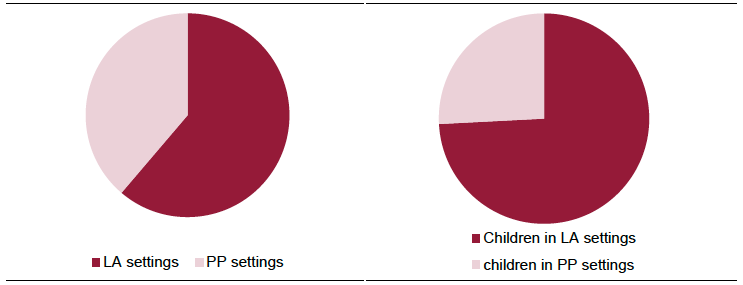
Source: Care Inspectorate Early learning and childcare statistics 2014
Partner providers
The provision of childcare to children under two and additional hours of childcare out-with the funded part-time entitlement is largely left to parents to arrange as they see fit with the private and third sector providers.
Local authorities hold powers to sub-contract private and third sector providers to deliver the funded entitlement in their area and to decide the rates paid to these partner providers. Up to 2007, the Scottish Government set a minimum advisory floor level of funding for local authorities to pay to partner providers. Following this it was left to local authorities to set their own rates. [26] Often this advisory floor is still used as a baseline to arrive at the current partner provider rates. This means that in many cases the (discontinued) advisory floor of £1,550 set in 2007 is uprated for inflation and the increase in funded hours. For reference, the hourly unit cost under the advisory floor in 2007 was £3.76. An uprating for inflation suggests an hourly rate of £4.36.
Partner providers are paid based on the number of children attending ( i.e. participation-based funding) at a pre-agreed rate per child usually set by the local authority. In some cases, partner providers submit bids in a tendering process in which they indicate at what rate they are willing to offer a funded place. The chapter on finance, expenditure and cost covers partner provider rates and estimated partner provider costs in more detail.
Support and quality improvement
Most local authorities offer additional free in-kind support to their partnership settings, in the form of staff training, staff development and continuing professional development and the resource directed to this also varies across different parts of Scotland. This can also include providing access to centrally employed teachers . The financial implications of this are discussed in the chapter on finance, costs and expenditure below.
Quality of childcare services
The Care Inspectorate and Education Scotland both have roles in assessing and improving quality of ELC providers. There is a range of activity on-going on the part of both inspectorates to facilitate streamlined and complementary inspection programmes.
The Care Inspectorate has a legal duty to regulate and inspect all registered care services (including childminders) providing both funded and non-funded ELC under the Public Services Reform (Scotland) Act 2010. Education Scotland has powers to inspect services providing funded ELC under the Education (Scotland) Act 1980. These inspections provide an independent evaluation of the quality of care and educational provision and promote improvement and innovation to enhance children's experiences and lead to better outcomes.
The Care Inspectorate assesses care against four quality themes each of which comprises a number of quality statements. The four themes are
- Quality of care and support
- Quality of environment
- Quality of staffing
- Quality of management and leadership
Education Scotland evaluates quality according to five Quality Indicators ( QIs), defined as
- Improvement in performance
- Children's experiences
- Meeting learning needs
- The curriculum
- Improvement through self-evaluation
For each indicator or theme, the setting is graded by both the Care Inspectorate and Education Scotland from 1 to 6, with six being the most positive grading. On average in any CI quality theme and in all but one Education Scotland QI, ELC settings are graded between good and very good. Overall quality in Scotland is consistently high and analysis of Growing Up in Scotland ( GUS) data found that very few children were attending settings that scored unsatisfactory grades over any of the indicators. [27]
Figure 6: Care Inspectorate's quality ratings of daycare services
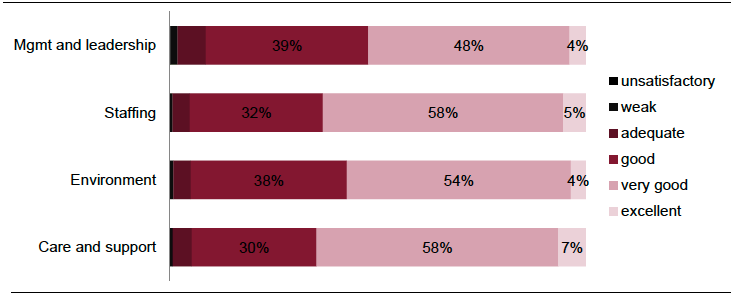
Source: Care Inspectorate Early learning and childcare statistics 2014
Specifically, the Care Inspectorate's assessment of the quality of childcare services presents positive results. Less than 1 per cent of all daycare services for children (funded and unfunded) were graded unsatisfactory or weak in the categories quality of care, quality of environment and quality of staffing, while around 95 per cent of all day care services were graded good, very good or excellent in these categories. Grades for childminders show a similar picture.
Table 13: Quality of childcare services
| unsatisfactory | weak | adequate | good | very good | excellent | |
|---|---|---|---|---|---|---|
| Daycare of Children | ||||||
| Care and support | 0.1% | 0.8% | 4.5% | 30.0% | 58.1% | 6.6% |
| Environment | 0.1% | 0.9% | 4.2% | 37.5% | 53.8% | 3.6% |
| Staffing | 0.1% | 0.7% | 4.2% | 31.9% | 57.8% | 5.4% |
| Mgmt and leadership | 0.3% | 1.7% | 6.8% | 39.0% | 48.3% | 3.9% |
| Childminding services | ||||||
| Care and Support | 0.1% | 0.3% | 3.3% | 31.5% | 57.3% | 7.5% |
| Environment | 0.1% | 0.4% | 3.3% | 34.4% | 56.6% | 5.3% |
| Staffing | 2.4% | 1.8% | 10.1% | 40.8% | 40.2% | 4.7% |
| Mgmt and leadership | 1.6% | 0.8% | 5.7% | 35.4% | 51.3% | 5.2% |
Source: Care Inspectorate Early learning and childcare statistics 2014
Provision of meals and snacks
In addition to the entitlement to funded ELC, children who meet the qualifying free school lunch criteria are also entitled to a free school lunch where they attend at lunch time.
The eligibility criteria for free school lunches for young children are equivalent to the funded ELC eligibility criteria for two year olds (see section on eligibility to early learning and childcare), although as a result of young children attending a morning or an afternoon session per day only a small proportion of children actually receive a free lunch.
Going forward, as a result of local authorities starting to offer greater flexibility and increases in the number of funded hours, it is to be expected that a larger number of children are going to attend over lunch time. Hence, where settings do not provide lunches as a result of a lack of cooking facilities, amendments to their infrastructure will have to be made.
Figure 7: Provision of lunches

Source: Care Inspectorate Early learning and childcare statistics 2014
As can be seen from table 14, many childcare services do not provide any meals. However, most offer snacks. While eligible children are entitled to a lunch, many do not attend over lunch time as this falls outside the hours during which the funded entitlement is offered in local authority settings. Local authorities have been provided with additional capital funding to adapt accommodation for the provision of meals ( e.g. kitchen and dining areas) and additional revenue to meet the costs of additional meals arising from more eligible children and more attending over lunch time.
Table 14: Provision of meal by provider type (funded and unfunded)
| Meals provided: | Snacks provided: | |||||||
|---|---|---|---|---|---|---|---|---|
| By service only | By parents only | By both | None | By service only | By parents only | By both | None | |
| Main service type: | ||||||||
| Childminding | 23% | 48% | 23% | 6% | 42% | 22% | 36% | 1% |
| Children / family centre | 40% | 15% | 15% | 29% | 82% | 2% | 15% | 0% |
| Crèche | 0% | 16% | 5% | 74% | 41% | 26% | 18% | 10% |
| Holiday play scheme | 0% | 60% | 7% | 34% | 21% | 34% | 37% | 9% |
| Nursery | 25% | 11% | 10% | 54% | 89% | 1% | 9% | 0% |
| of which: providing add. serv. | 32% | 22% | 21% | 25% | 83% | 1% | 16% | 0% |
| of which: no add. services | 24% | 9% | 8% | 59% | 91% | 1% | 8% | 0% |
| Out of school care | 3% | 10% | 3% | 83% | 69% | 3% | 27% | 1% |
| of which: providing add. serv. | 4% | 13% | 4% | 79% | 69% | 3% | 28% | 0% |
| of which: no add. services | 1% | 3% | 1% | 92% | 67% | 2% | 25% | 3% |
| Playgroup | 3% | 11% | 0% | 86% | 88% | 4% | 8% | 0% |
| Other services | 11% | 28% | 7% | 54% | 52% | 11% | 26% | 11% |
| Total | 22% | 34% | 17% | 28% | 58% | 14% | 27% | 1% |
| Total (excl. childminders) | 19% | 12% | 8% | 61% | 83% | 3% | 13% | 1% |
Source: Care Inspectorate Early learning and childcare statistics 2014
Geography
72 per cent of all childcare services (74 per cent excl. childminders), including those not providing the funded entitlement, are located in urban areas (approximately 62 per cent of the Scottish population lives in urban areas).
In large urban areas, the market is split evenly between private and public providers (46 per cent each). In other urban areas, accessible small towns and accessible rural areas, nurseries run by local authorities become more prevalent (60 per cent to 70 per cent of nurseries run by local authorities). In remote rural areas, 85 per cent of nurseries are run by local authorities. Across all geographical areas, between 7 per cent and 10 per cent of nurseries are run by third sector providers. [28]
If childminders are excluded, daycare services are distributed relatively equally across all areas as categorised by the Scottish Index of Multiple Deprivation ( SIMD). [29] There does not appear to be a higher density of daycare services in more affluent areas. However, in more deprived areas childcare is provided to a slightly larger extent by local authorities, whereas private providers tend to operate in less deprived areas.
Table 15: Share of settings by sector and index level of deprivation
| SIMD category | Local authority settings | Private and third sector settings |
|---|---|---|
| 1 - most deprived | 55% | 45% |
| 2 | 57% | 43% |
| 3 | 57% | 43% |
| 4 | 62% | 38% |
| 5 | 54% | 46% |
| 6 | 54% | 46% |
| 7 | 47% | 53% |
| 8 | 39% | 61% |
| 9 | 41% | 59% |
| 10 - least deprived | 29% | 71% |
Source: Care Inspectorate Annual Returns, Improvement Service SIMD data
The average distance between the two nearest daycare services (as defined by postcode area) for children under five across Scotland is 2.42 kilometres. As expected, there is large variation, depending on the specific region, with rural areas exhibiting much greater average distances between the two nearest childcare providers. For example, the distance between two childcare providers in Edinburgh and Glasgow is less than 1 kilometre, whereas on the Orkney Islands childcare settings are on average more than 9 kilometres apart.
Figure 8: Average distance between daycare centres in kilometres by local authority
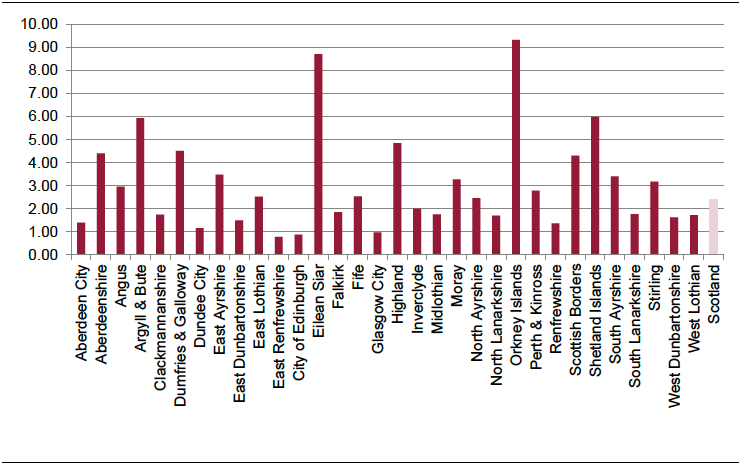
Source: Ordnance Survey data, Royal Mail data and National Statistics data
Figure 9: Map of settings providing the funded entitlement
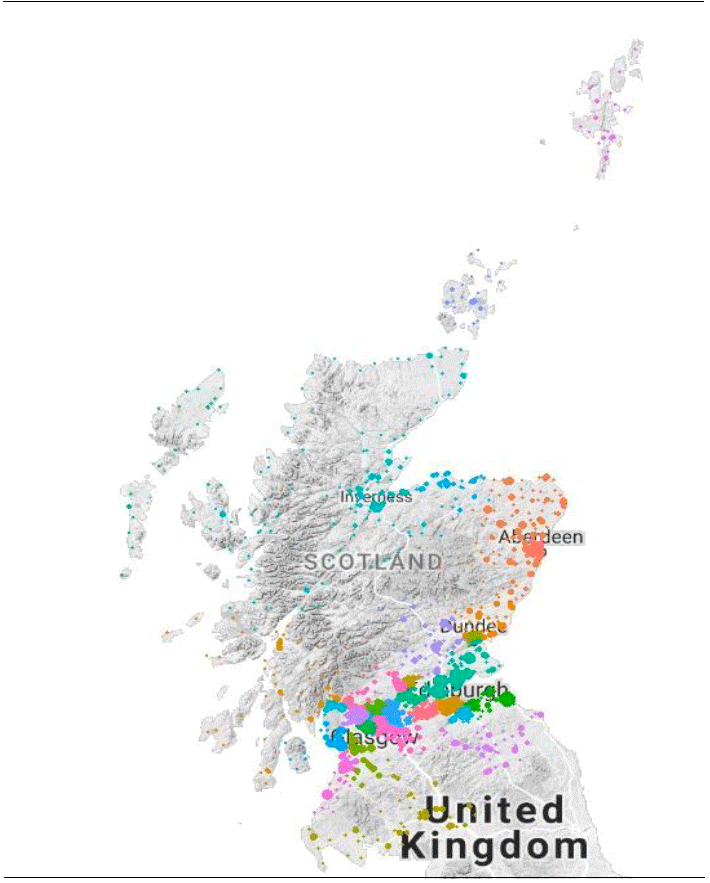
Source: Care Inspectorate Annual returns, Ordnance Survey data, Royal Mail data and National Statistics data; Map data ©2016 Google
If only settings that provide the funded entitlement are considered, the average distance between two settings slightly increases to 3.07 kilometres. Figure 9 shows a map of these settings, where the colour of the dots indicate the different local authorities and the size of the dots the size of the respective establishment.
Table 16: Average distances between daycare settings across Scotland [30]
| Local authority | Avg. distance between settings in km - all settings | Avg. distance between settings in km - funded settings only |
|---|---|---|
| Aberdeen City | 1.40 | 1.66 |
| Aberdeenshire | 4.40 | 4.74 |
| Angus | 2.96 | 3.61 |
| Argyll & Bute | 5.94 | 6.57 |
| Clackmannanshire | 1.74 | 2.05 |
| Dumfries & Galloway | 4.51 | 4.94 |
| Dundee City | 1.16 | 1.56 |
| East Ayrshire | 3.48 | 4.64 |
| East Dunbartonshire | 1.50 | 2.18 |
| East Lothian | 2.53 | 3.12 |
| East Renfrewshire | 0.78 | 1.56 |
| City of Edinburgh | 0.88 | 1.15 |
| Eilean Siar | 8.71 | 9.39 |
| Falkirk | 1.85 | 2.59 |
| Fife | 2.53 | 2.86 |
| Glasgow City | 0.97 | 1.27 |
| Highland | 4.85 | 5.65 |
| Inverclyde | 2.01 | 2.05 |
| Midlothian | 1.75 | 2.29 |
| Moray | 3.27 | 3.71 |
| North Ayrshire | 2.46 | 2.99 |
| North Lanarkshire | 1.70 | 2.23 |
| Orkney Islands | 9.34 | 10.33 |
| Perth & Kinross | 2.79 | 3.86 |
| Renfrewshire | 1.36 | 1.33 |
| Scottish Borders | 4.31 | 5.02 |
| Shetland Islands | 6.00 | 7.64 |
| South Ayrshire | 3.41 | 5.07 |
| South Lanarkshire | 1.77 | 2.05 |
| Stirling | 3.17 | 3.56 |
| West Dunbartonshire | 1.62 | 2.04 |
| West Lothian | 1.72 | 2.56 |
| Scotland | 2.42 | 3.07 |
Source: Scottish Government
Cost to parents
The Family and Childcare Trust undertake an annual survey of local authorities across the UK asking them about childcare prices in their area. [31] In practice, local authorities then conduct a review of childcare prices within their region themselves. table 17 below lists the result of the 2016 survey. At £4.16 per hour for twos and over, the funded provision of childcare is potentially worth as much as £2,496 per eligible child per year.
Note that these prices are an average of prices at private/third sector settings and largely subsidised prices in local authority settings and therefore might not be reflective of the actual costs of provision or prices parents typically face for extra hours out-with the funded entitlement as local authority provision of wrap-around hours can be patchy. Also note that the study groups prices for two year olds together with those for children over two, who will have different costs and prices practice.
Table 17: Average prices for one hour of ELC as estimated by FACT
| Region | Nursery per hour (under 2) | Nursery per hour (2 and over) | Childminder per hour (under 2) | Childminder per hour (2 and over) |
|---|---|---|---|---|
| Eastern Scotland | £4.56 | £4.27 | £3.60 | £4.52 |
| Highland and Islands and NE Scotland | £4.54 | £4.47 | £3.49 | £4.28 |
| South Western Scotland | £4.29 | £4.08 | £3.54 | £4.36 |
| Overall Scotland average | £4.45 | £4.16 | £3.55 | £4.40 |
| Britain average of regions and nations | £4.67 | £4.48 | £3.26 | £4.24 |
Source: FACT childcare survey 2015
Contact
There is a problem
Thanks for your feedback